| Listing 1 - 10 of 10 |
Sort by
|
Book
ISBN: 0128005890 0128001887 9780128005897 9780128001882 Year: 2015 Publisher: Amsterdam
Abstract | Keywords | Export | Availability | Bookmark
 Loading...
Loading...Choose an application
- Reference Manager
- EndNote
- RefWorks (Direct export to RefWorks)
The Comprehensive Sourcebook of Bacterial Protein Toxins 4th Edition, contains chapters written by internationally known and well-respected specialists. This book contains chapters devoted to individual toxins, as well as chapters that consider the different applications of these toxins. Considerable progress has been made in understanding the structure, function, interaction and trafficking into cells, as well as mechanism of action of toxins. Bacterial toxins are involved in the pathogenesis of many bacteria, some of which are responsible for severe diseases in human and animals, but can al
Bacterial toxins. --- Bacterial antigens --- Microbial toxins
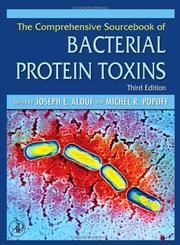
ISBN: 9780120884452 0120884453 0080456987 9780080456980 9786610628469 1280628464 Year: 2006 Publisher: Amsterdam ; Boston : Elsevier,
Abstract | Keywords | Export | Availability | Bookmark
 Loading...
Loading...Choose an application
- Reference Manager
- EndNote
- RefWorks (Direct export to RefWorks)
This book describes the major achievements and discoveries relevant to bacterial protein toxins since the turn of the new century illustrated by the discovery of more than fifty novel toxins (many of them identified through genome screening). The establishment of the three-dimensional crystal structure of more than 20 toxins during the same period offers deeper knowledge of structure-activity relationships and provides a framework to understand how toxins recognize receptors, penetrate membranes and interact with and modify intracellular substrates.* Edited by two of the most highly re
Bacterial toxins. --- Bacterial antigens --- Microbial toxins
Book
ISBN: 3038427039 Year: 2018 Publisher: Basel, Switzerland : MDPI,
Abstract | Keywords | Export | Availability | Bookmark
 Loading...
Loading...Choose an application
- Reference Manager
- EndNote
- RefWorks (Direct export to RefWorks)
Bridging cellular membranes is a key step in the pathogenic action of both binary and pore-forming bacterial toxins. The former use their translocation domains, containing various structural motifs, to ensure efficient delivery of the toxic component into the host cell, while the latter act on the cellular membrane itself. In either case, the integrity of the membrane is compromised via targeted protein-lipid and protein-protein interactions triggered by specific signals, such as proteolytic cleavage or endosomal acidification. This Special Issue presents recent advances in characterizing functional, structural and thermodynamic aspects of the conformational switching and membrane interactions involved in the cellular entry of bacterial protein toxins. Deciphering the physicochemical principles underlying these processes is also a prerequisite for the use of protein engineering to develop toxin-based molecular vehicles capable of targeted delivery of therapeutic agents to tumors and other diseased tissues.
Bacterial toxins. --- Bacterial antigens --- Microbial toxins
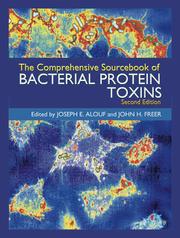
ISBN: 0120530759 Year: 1999 Publisher: London Academic press
Abstract | Keywords | Export | Availability | Bookmark
 Loading...
Loading...Choose an application
- Reference Manager
- EndNote
- RefWorks (Direct export to RefWorks)
Medical microbiology, virology, parasitology --- Bacterial toxins --- Bacterial antigens --- Microbial toxins --- Bacterial toxins.
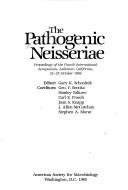
ISBN: 091482676X Year: 1985 Publisher: Washington (D.C.): American society for microbiology
Abstract | Keywords | Export | Availability | Bookmark
 Loading...
Loading...Choose an application
- Reference Manager
- EndNote
- RefWorks (Direct export to RefWorks)
Neisseria. --- Bacterial antigens --- Gonorrhea --- -Meningitis --- -Neisseria gonorrhoeae --- Neisseria meningitidis --- Meningococcus --- Meningitis --- Neisseria --- Diplococcus gonorrhoeae --- Gonococcus --- Micrococcus gonorrhoea --- Neisser's coccus --- Leptomeningitis --- Central nervous system --- Genitourinary organs --- Neisseria infections --- Sexually transmitted diseases --- Urethritis --- Antigens --- Bacteria --- Microbiology --- Diseases --- Infections --- Bacterial antigens. --- Neisseria gonorrhoeae. --- Neisseria meningitidis. --- Microbiology. --- congresses. --- Congresses. --- Neisseria gonorrhoeae
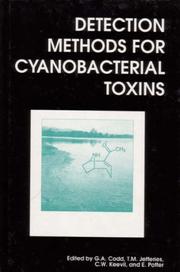
ISBN: 1845698169 1855738023 9781845698164 9781855738027 9780851869612 Year: 1994 Publisher: Cambridge, England
Abstract | Keywords | Export | Availability | Bookmark
 Loading...
Loading...Choose an application
- Reference Manager
- EndNote
- RefWorks (Direct export to RefWorks)
Cyanobacteria, or blue-green algae, commonly occur in a variety of water types throughout the world. A variable, but, high proportion of the cyanobacterial blooms and scums, which can develop annually in lakes, reservoirs, canals and slow-flowing rivers, contain potent toxins. Although animal poisonings and human health problems associated with the ingestion of, or contact with, cyanobacterial scums have long been recognized, a developing understanding of the health hazards posed by the toxins requires that reliable, sensitive, specific and convenient methods are available for their detection
Bacterial toxins --- Cyanobacteria --- Analysis --- Bacteria, Blue-green --- Blue-green algae --- Blue-green bacteria --- Blue-greens (Microorganisms) --- Cryptophyceae --- Cyanochloronta --- Cyanophyceae --- Cyanophycota --- Cyanophyta --- Myxophyceae --- Myxophyta --- Phycochromophyceae --- Schizophyceae --- Prokaryotes --- Bacterial antigens --- Microbial toxins
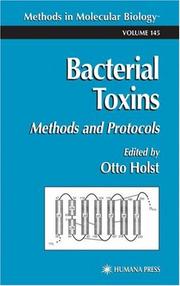
ISBN: 0896036049 9786610820443 1280820446 1592590527 Year: 2000 Publisher: Totowa, NJ : Humana Press : Imprint: Humana,
Abstract | Keywords | Export | Availability | Bookmark
 Loading...
Loading...Choose an application
- Reference Manager
- EndNote
- RefWorks (Direct export to RefWorks)
The interest of investigators across a broad spectrum of scientific dis- plines has been steadily stimulated by the field of bacterial toxin research, an area that makes use of a large variety of biological, chemical, physicochemical, and medically oriented approaches. Researchers studying bacterial toxins need to be acquainted with all these disciplines in order to work effectively in the field. To date, there has been no published collection offering detailed descr- tions of the techniques and methods needed by researchers operating across the field’sdiverse areas. The present volume Bacterial Toxins: Methods and Pro- cols, is intended to fill this gap. Bacterial Toxins: Methods and Protocols consists of two sections: one on protein toxins (15 chapters) and one on endotoxins (5 chapters). Each s- tion is introduced by an overview article (Chapters 1 and 16). The protocols collected represent state-of-the-art techniques that each have high impact on future bacterial toxin research. All methods are described by authors who have regularly been using the protocol in their own laboratories. Included in each chapter is a brief introduction to the method being described.
Bacterial toxins -- Research -- Methodology. --- Electronic books. -- local. --- Microbial toxins. --- Bacterial toxins --- Toxins, Biological --- Biological Factors --- Bacterial Toxins --- Chemicals and Drugs --- Human Anatomy & Physiology --- Health & Biological Sciences --- Animal Biochemistry --- Research --- Methodology --- Agrotechnology and Food Sciences. Toxicology --- Methodology. --- Natural Toxins --- Natural Toxins. --- Toxins --- Bacterial antigens --- Microbial toxins --- Microbiology. --- Microbial biology --- Biology --- Microorganisms
Book
ISBN: 3319676512 3319676504 Year: 2018 Publisher: Cham : Springer International Publishing : Imprint: Springer,
Abstract | Keywords | Export | Availability | Bookmark
 Loading...
Loading...Choose an application
- Reference Manager
- EndNote
- RefWorks (Direct export to RefWorks)
Bacterial Pathogens and their Virulence Factors contains a detailed description of 32 major bacterial pathogens that affect human health and their associated virulence determinants. Chapter 1 gives an overview of the different types and classes of general virulence factors involved in host cell adherence and invasion, dissemination within the host, host cell damage, and evasion of host defense systems, as well as mechanisms by which these virulence factors are regulated. Chapters 2 through 33 give concise descriptions of the disease states associated with the 32 bacterial genera and their major pathogenic species, along with an in-depth description of the individual virulence factors that have been found to be functionally involved in pathogenicity. A detailed bibliography derived from primary literature and review articles accompanies each of these chapters, allowing the reader to delve more deeply into individual pathogens and their virulence determinants.Chapter 34 discusses the exciting possibilities and initial successes of using detailed information on a pathogen’s virulence toolkit to design new therapeutics aimed at specific virulence traits.
Medicine. --- Medical microbiology. --- Infectious diseases. --- Bacteriology. --- Medicine & Public Health. --- Infectious Diseases. --- Medical Microbiology. --- Bacteria. --- Bacterial toxins. --- Bacterial antigens --- Microbial toxins --- Germs --- Microbes --- Prokaryotes --- Emerging infectious diseases. --- Microbiology. --- Microbiology --- Emerging infections --- New infectious diseases --- Re-emerging infectious diseases --- Reemerging infectious diseases --- Communicable diseases --- Microbial biology --- Biology --- Microorganisms
Book
ISBN: 0123838509 Year: 1978 Publisher: London,New York : Academic Press,
Abstract | Keywords | Export | Availability | Bookmark
 Loading...
Loading...Choose an application
- Reference Manager
- EndNote
- RefWorks (Direct export to RefWorks)
Bacterial Toxins --- Cell Membrane --- Bacterial toxins --- Cell membranes --- Toxines bactériennes --- Membrane cellulaire --- Bacterial Toxins. --- Cell Membrane. --- Cell surfaces --- Cytoplasmic membranes --- Plasma membranes --- Plasmalemma --- Membranes (Biology) --- Bacterial antigens --- Microbial toxins --- Cytoplasmic Membrane --- Plasma Membrane --- Cell Membranes --- Cytoplasmic Membranes --- Membrane, Cell --- Membrane, Cytoplasmic --- Membrane, Plasma --- Membranes, Cell --- Membranes, Cytoplasmic --- Membranes, Plasma --- Plasma Membranes --- Membranes --- Toxins, Bacterial --- Bacterial toxins. --- Cell membranes. --- Toxines bactériennes --- Glycocalyces --- Bacterial Toxin --- Toxin, Bacterial
Book
ISBN: 3319588931 3319588915 Year: 2017 Publisher: Cham : Springer International Publishing : Imprint: Springer,
Abstract | Keywords | Export | Availability | Bookmark
 Loading...
Loading...Choose an application
- Reference Manager
- EndNote
- RefWorks (Direct export to RefWorks)
This volume focuses on the transport of medically relevant bacterial protein toxins into mammalian cells, and on novel pharmacological strategies to inhibit toxin uptake. The first chapters review our current understanding of the cell-surface receptors and cellular transport processes of Clostridium botulinum neurotoxins, Clostridium botulinum C3 toxin, Clostridium difficile toxins, binary clostridial enterotoxins, anthrax toxins and diphtheria toxin. In brief, specific binding/transport (B) subunits deliver the enzyme (A) subunits into the cytosol, where the latter modify their substrates, producing cytotoxic effects and the characteristic toxin-associated diseases. Key mechanisms for the transport of the A subunits from endosomes into the cytosol and the role of trans-membrane pores formed by the B subunits and host cell chaperones for this process are reviewed. The book’s closing chapters focus on compounds which inhibit the transport of the A subunits from endosomes into the cytosol and therefore might lead to novel therapeutic strategies for toxin-associated diseases. These substances include pharmacological inhibitors of the host cell chaperones involved, as well as multivalent and heterocyclic molecules that specifically block the toxins’ translocation channels. This volume offers an up-to-date resource for scientists.
Medicine. --- Medical microbiology. --- Pharmacology. --- Infectious diseases. --- Biomedicine. --- Medical Microbiology. --- Pharmacology/Toxicology. --- Infectious Diseases. --- Drug effects --- Medical pharmacology --- Medical sciences --- Chemicals --- Chemotherapy --- Drugs --- Pharmacy --- Clinical sciences --- Medical profession --- Human biology --- Life sciences --- Pathology --- Physicians --- Physiological effect --- Bacterial toxins. --- Bacterial antigens --- Microbial toxins --- Microbiology. --- Toxicology. --- Emerging infectious diseases. --- Emerging infections --- New infectious diseases --- Re-emerging infectious diseases --- Reemerging infectious diseases --- Communicable diseases --- Medicine --- Pharmacology --- Poisoning --- Poisons --- Microbial biology --- Biology --- Microorganisms --- Toxicology
| Listing 1 - 10 of 10 |
Sort by
|

 Search
Search Feedback
Feedback About UniCat
About UniCat  Help
Help News
News